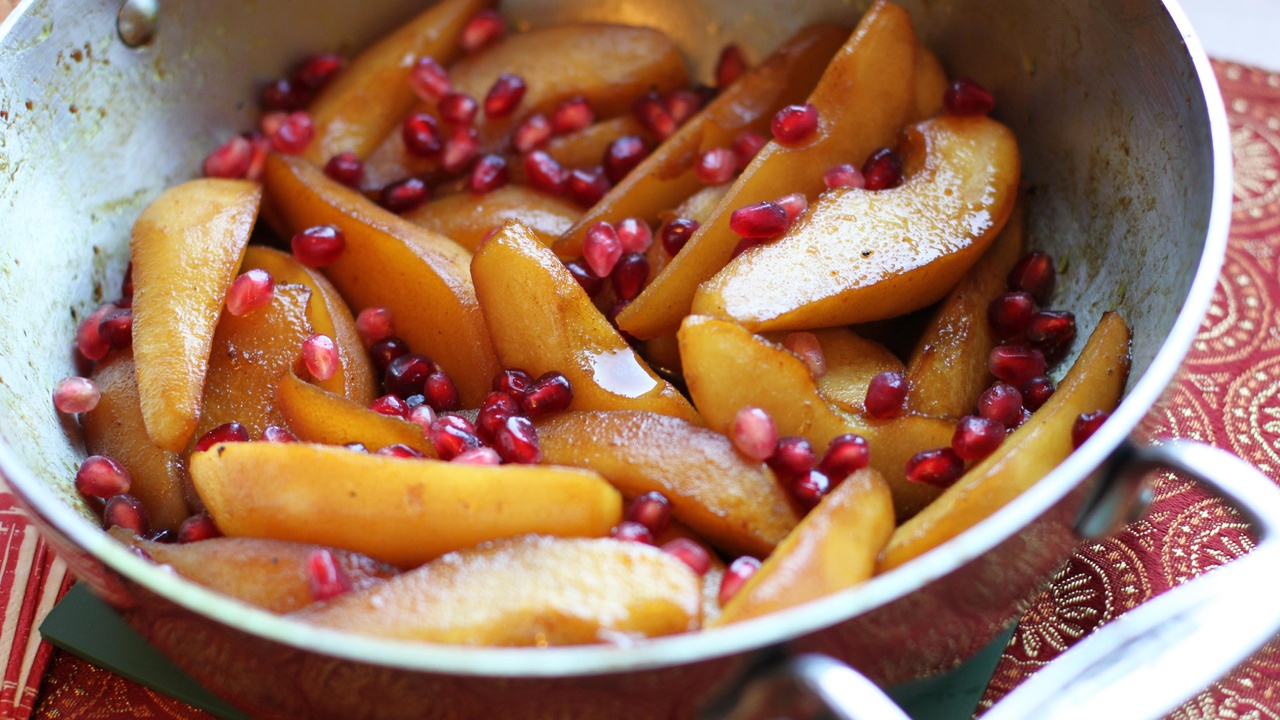Steamed Artichokes with Garlic, Lemon & Fennel Aioli
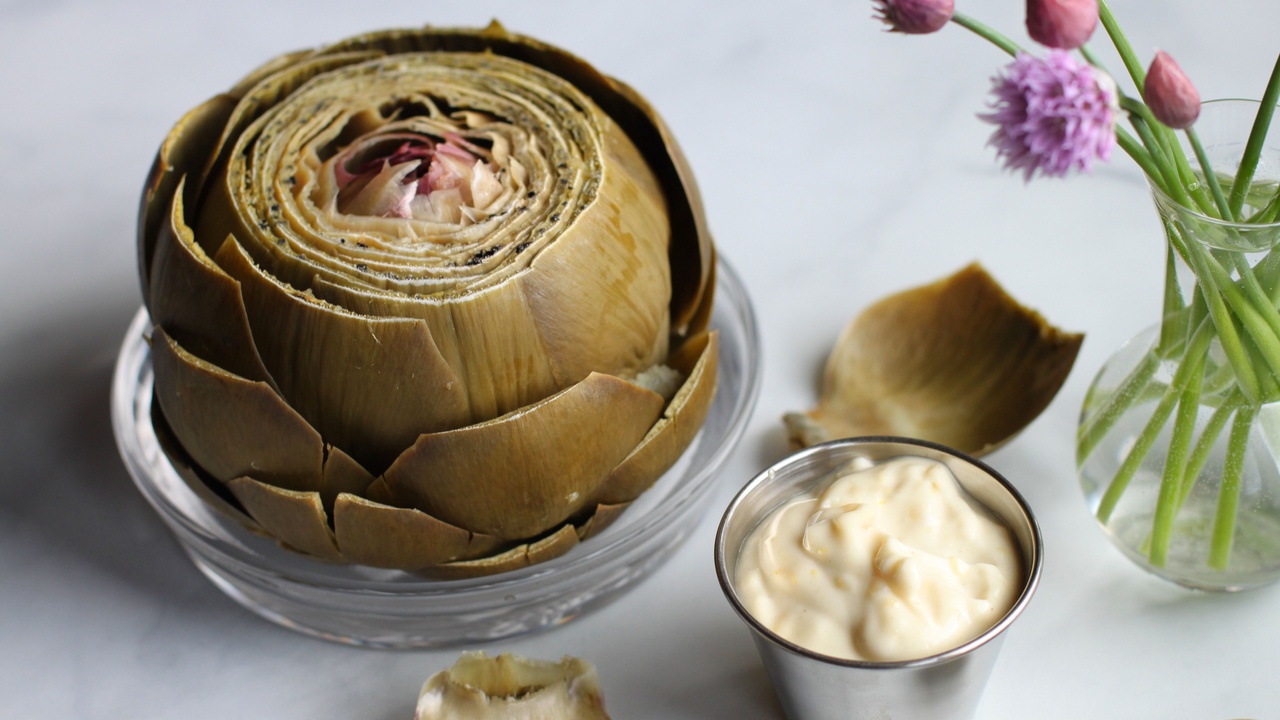
These steamed artichokes with garlic, lemon, and fennel aioli are an impressive dish, with an impressive amount of nutrition and health benefits. For what can be an intimidating new vegetable for the uninitiated, this cooking method also happens to be the most approachable way to get to know them.
If you’ve never eaten an artichoke, or don’t know how, today is your lucky day, for I am going to teach you how to embrace this odd delicacy, and forever be changed. If you're unfamiliar with how to cook, purchase, store, or eat this edible thistle, we'll cover all of that in this post.
We'll also cover some of the unique thyroid-healthy aspects of artichokes, and why they could be your new favorite thyroid-healthy side.
This recipe happens to be gluten-free, dairy-free, Paleo, low-carb, and vegan.
Full disclosure: Some of the links in this post may be affiliate links. As an Amazon Associate, I earn from qualifying purchases. Purchasing a product using one of these links will support my work at no additional cost to you. Please know that I only recommend products I wholeheartedly stand by.
An Ode to My Favorite Vegetable
Plucking the leaves from this edible, giant flower bud, dipping them into some luscious sauce, sliding them between your teeth, and working your way to the grand finale: The Heart! With its tender mouthfuls of incomparable vegetal flavor... There is nothing quite like eating a whole globe artichoke.
To me, artichokes aren't just another thyroid-healthy vegetable with amazing detoxifying properties, they're a big part of my life story and my #1 favorite vegetable. If I ever write a foodoir, they will have a starring role.
On birthdays, when my mom would ask me what I wanted for my birthday dinner, I have no recollection of any other menu item requested besides artichokes. The flavor, the sauce, and the ritual were and still are so fun. Poetic even.
As a kid, I especially loved the dipping sauce, which back then was hollandaise from a packet. These days, we opt for something cleaner, scratch-made, and more delicious like this Garlic, Lemon, & Fennel Aioli.
My husband Noah and I ADORE artichokes and eat them as often as we can. It was soon after I met this cute snowboarder from Big Sky that I remember calling my mother to gush, “Mom, he made me artichokes.”
We were 19 years old. It was love at first bite.
Twenty-six years later, Noah and I are still eating artichokes as often as we can. They're our special vegetable (What? Doesn't everyone have a special vegetable?).
Our artichoke romance has remained steadfast over the years, deepening even, as we have come to appreciate their cleansing and detoxifying qualities. They stimulate the liver, and gall bladder, including the production of bile. In other words, they are a digestive aid and help break down fat.
When we lived in Alaska and could get our hands on a batch of crab legs (which was often), we always served them with artichokes to help our bodies process the rich meal. They make a great first course and can be boiled, fried, roasted, and even stuffed, but steaming is the simplest, quickest, and easiest way to enjoy them.
Further Reading: Top 5 Detoxifying Foods for Thyroid Thrivers
Chef's Notes:
The dipping sauce included in this recipe is a magical flavor combination when paired with this magical edible thistle. Toasted garlic and garlic-infused oil, plus the licorice perfume of ground fennel seed combine with tart lemon, and creamy mayonnaise to make a simple aioli that highlights the taste of the artichokes.
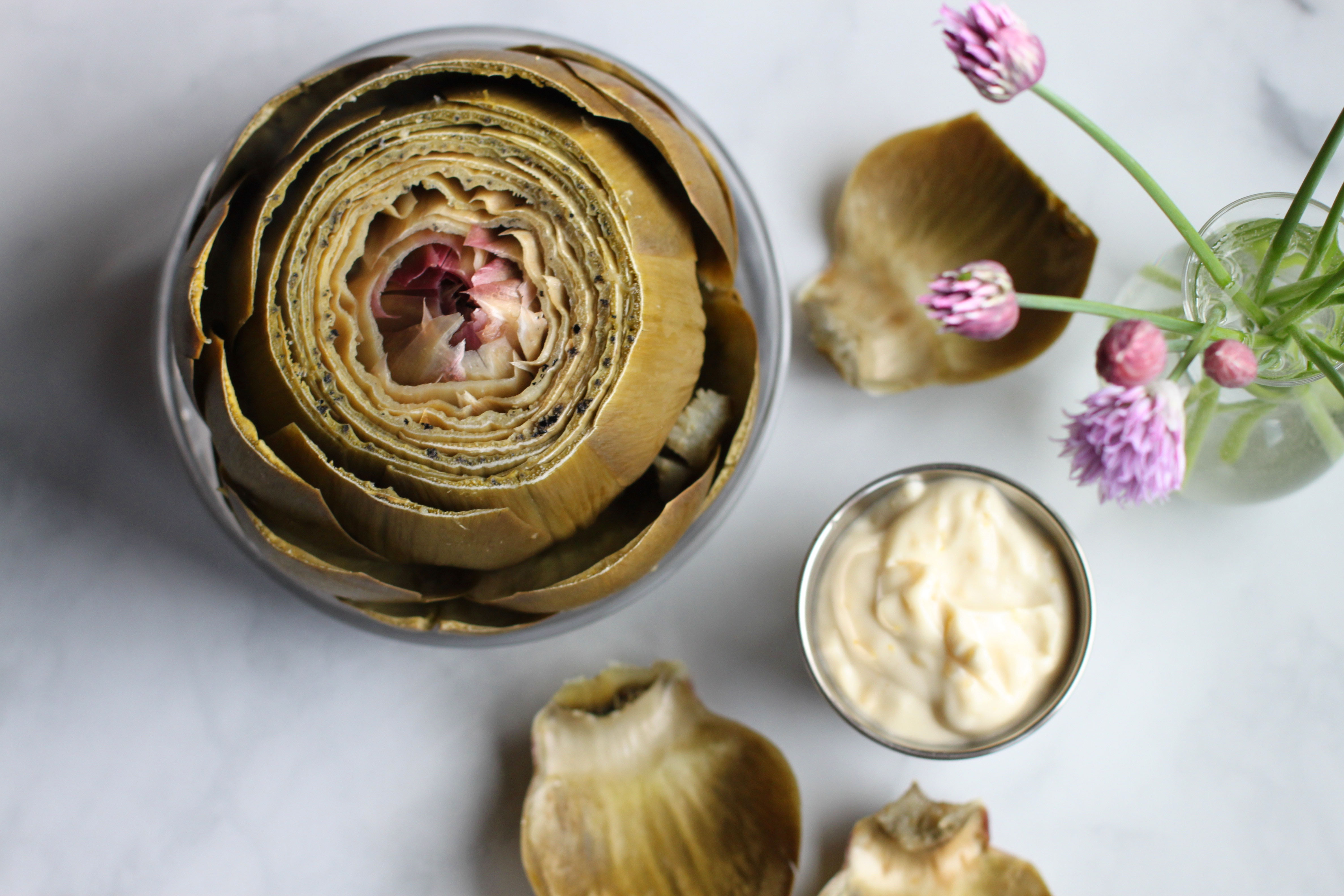
What Do Artichokes Taste Like?
The taste of artichokes is tricky to describe because there's nothing quite like them. Some compare the taste to asparagus, but it's sweeter than that. Some compare the taste to brussels sprouts, but the flavor is far less pungent than that. Some compare the taste to celery, which is practically an insult to the complex and toothsome artichoke. They truly are are in a class of their own.
Artichokes can also be tricky to pair with other flavors. For wine lovers, they have an especially difficult reputation. This is because a natural compound in the artichoke called cynarin shuts off the sweet receptors on our tongue. When another food or drink is added, the cynarin is washed away and any natural sweetness is amplified. To simplify, artichokes can make other foods and beverages taste different than they normally do.
I recommend serving them with simple pairings like grilled steak, shellfish, chicken, salmon, or pork loin, and a simple side like these dairy-free mashed potatoes, crispy grill fries, toasted quinoa, rice, or cauliflower rice.
Further Reading: Cooking with Wine the Thyroid-healthy Way
Tips for Buying Artichokes
- Early spring is the peak season for artichokes, but they are spottily available throughout the summer with another spike in late fall.
- Look for specimens that are heavy, indicating that they still contain lots of moisture and haven't dried out.
- Artichokes should have fleshy green leaves that feel firm when squeezed around the base.
- When squeezed, a squeaky noise from the leaves is a good sign of freshness.
- The size of the artichoke matters only in regard to cooking time. You may want to select artichokes of similar size to ensure similar cooking time.
- Some bruising or brown marks on the outside of the leaves are of no concern and may even indicate the artichoke has been sweetened by frost, but avoid artichokes with significant dark brown marks on the inner part of the leaves, and close to the heart, as this may indicate damage from pests.
- Store in the vegetable drawer for 1 to 1 1/2 weeks, but the sooner they are eaten, the better.
Organic vs Conventional Artichokes:
While I have struggled to find a definitive source on this, conventional artichokes have a reputation for being heavily sprayed with pesticides. According to Scientific American, organic food really is best for thyroid-healthy eating. Researchers have found links between common pesticides and an increased risk of thyroid disease, especially among women. Also, 60% of common pesticides and fertilizers have been shown to affect the thyroid gland’s ability to produce thyroid hormones.
To be on the safe side, buying organic artichokes is best.
View this post on Instagram
How to Steam an Artichoke
1. First, fill a large lidded pot with 1 1/2-inches of water. If you like, you can add seasonings to the water like bay leaf, fennel seed, coriander seed, allspice berries, peppercorns, garlic, salt, and/or chili flakes. This will impart a subtle flavor to the artichokes but is not required.
2. Next, place a steamer basket inside the pot.

3. Pull any scrappy-looking lower leaves from the base of the artichoke.
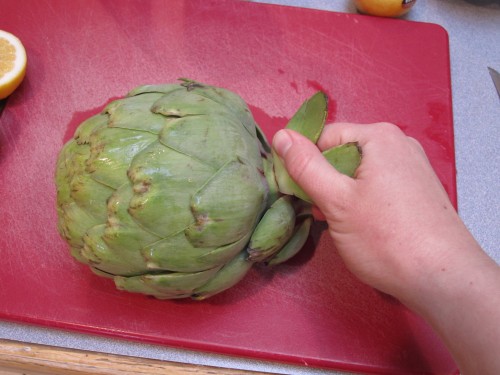
4. Halve a lemon, and keep it nearby. Cut the stem from the base of the artichoke, making a smooth, level cut so that the artichoke can sit upright.
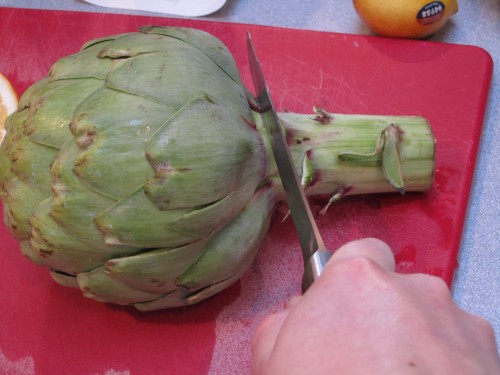
5. Immediately rub the cut surface with lemon to prevent oxidization (i.e. browning). Artichokes turn brown quickly wherever they’re cut, so don’t delay.
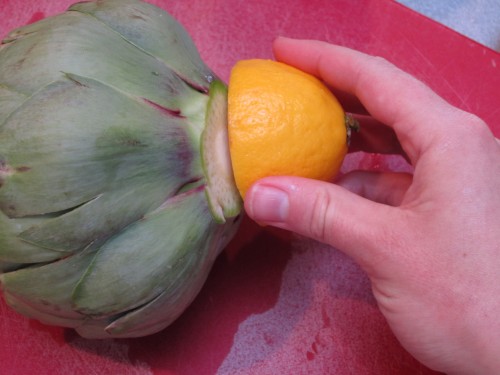
6. Slice the top 1/3 from the artichoke.

7. Again, rub the cut surface with lemon.
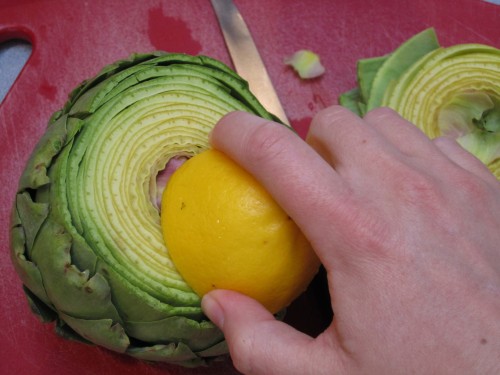
8. Use scissors or kitchen shears to snip the tips from the leaves. This tidies them up and removes thorns if there are any.
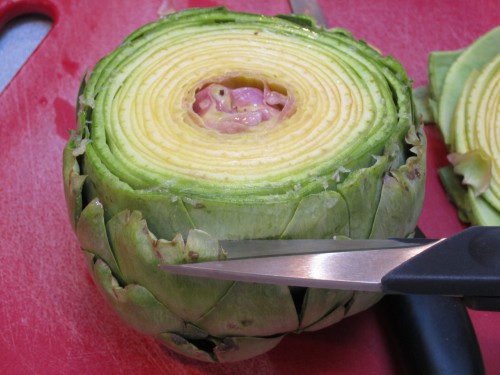
9. Again, rub the cut surfaces with lemon.
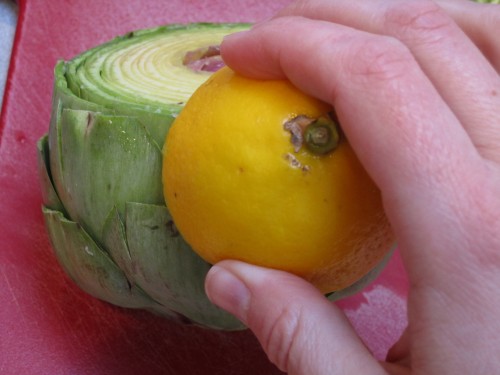
10. Place artichokes into the pot fitted with a steamer basket. Squeeze the remaining lemon juice all over the artichokes and into the pot. Bring water to a boil, cover the pot, and reduce heat to medium. Let simmer for 1 hour.
NOTE: Some cooks recommend placing the artichokes in the pot stem-end-up. I've tested them right-side-up, upside-down, and sideways, and personally, don't detect any noticeable difference, but I do try to occasionally rotate them in the pot to ensure even cooking.
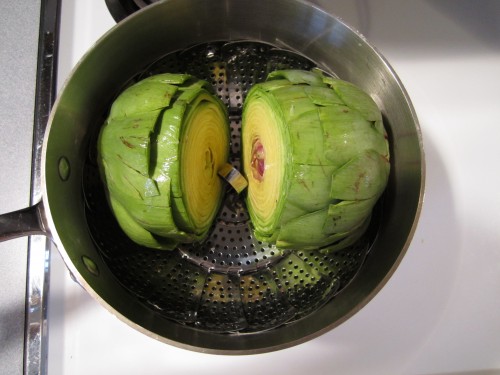
11. After 1-hour check artichokes for doneness by tugging at a couple of the inner leaves with tongs. They should pull away easily from the artichoke when done.
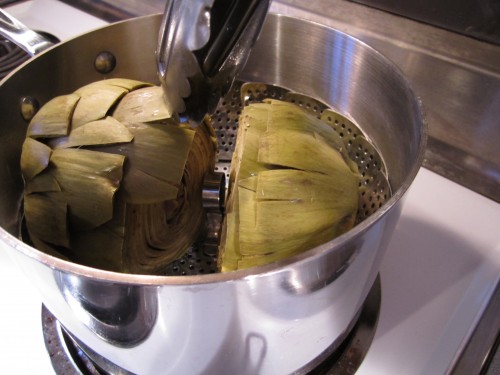
How to Eat an Artichoke
First, test the artichokes for doneness. After pulling a few test leaves, let them cool enough to handle, and then taste for doneness by sliding the meaty end of the leaf between your teeth. The flesh should be soft and tender, not tough. If it's still tough, continue cooking the artichokes until tender.
When fully steamed and tender, artichokes can hold for a while until you're ready to serve the meal. Simply remove the pot from the heat and let rest, covered until ready to dine. They retain heat for quite some time, so don't worry about them getting cold.
When you're ready to eat, serve artichokes with ramekins of your favorite dipping sauce. Putting a bowl on the table for discarded leaves is also nice to have. Enjoy the artichoke by pulling the leaves off, dipping the meaty end into your chosen sauce, and then sliding that meaty end of the leaf between your teeth to scrape off the tender flesh. The rest of the leaf is usually too tough to eat.
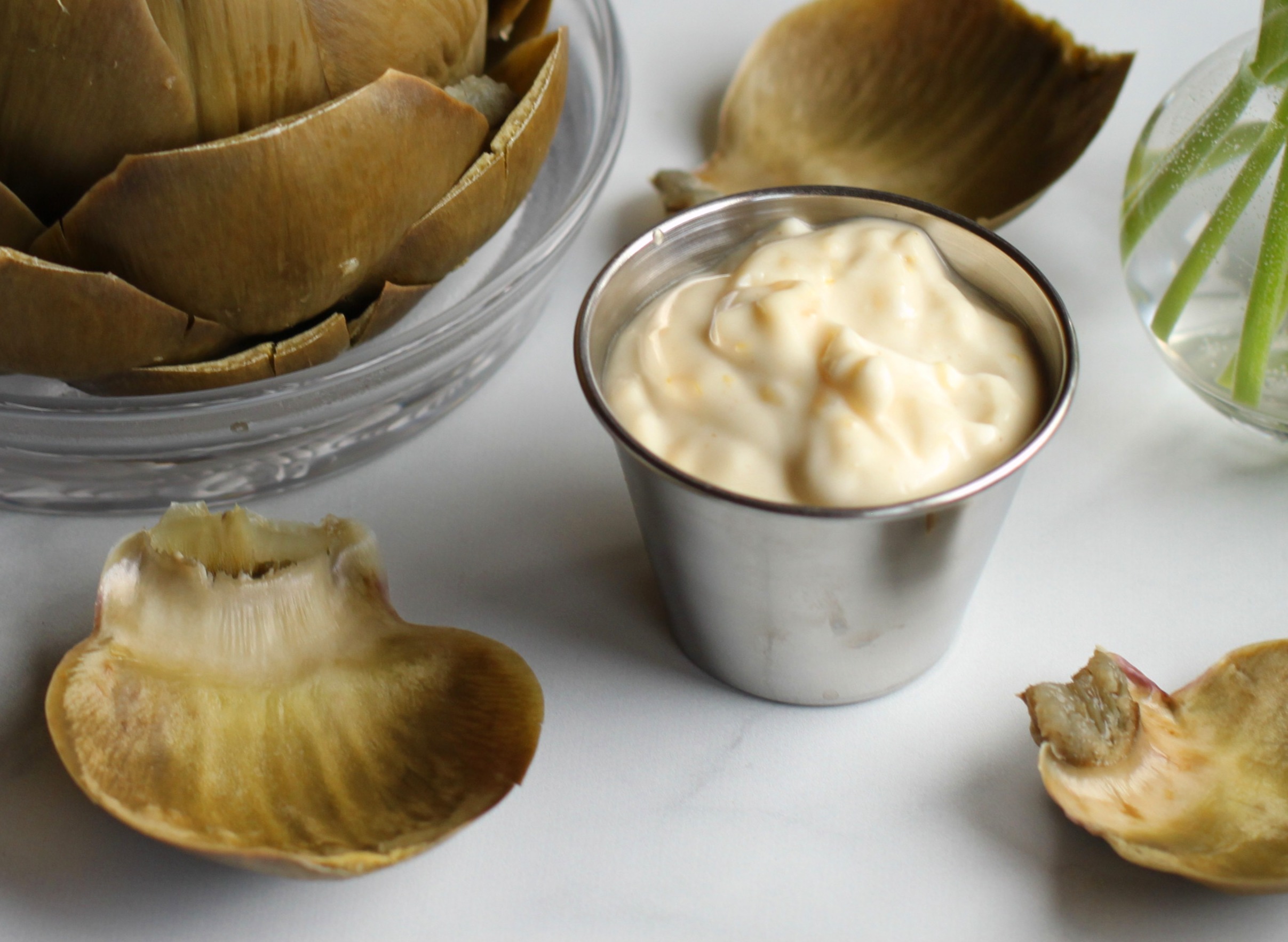
Once you get towards the middle, the leaves become more and more delicate, until eventually, you reach the furry inner part of the thistle, also known as the "choke". These fine hairs are not recommended to eat, but the meaty "heart" beneath the choke is the best part of the artichoke.
Remove the "choke" to get to the heart by either pulling with your fingers, scraping with a spoon, or cutting it away with the edge of a table knife. Depending on the artichoke, the hairs may come away easily, or may need to be cut away. Try pulling with your fingers first, and if they're stubborn, scrape them away with your table knife.
Here's what the choke looks like (on the right side), and what the heart looks like once the choke has been removed (on the left side).
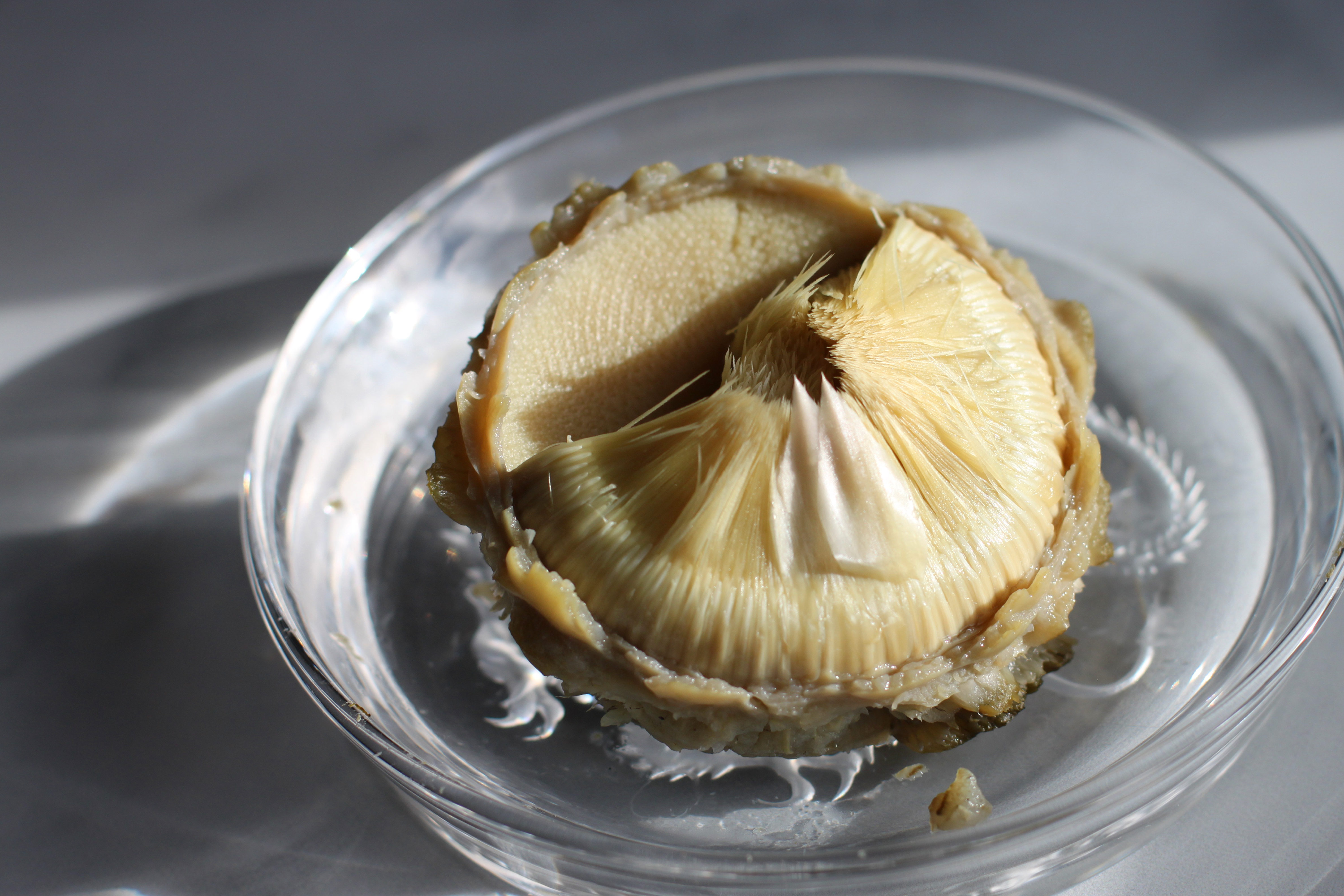
Once the choke has been fully removed, cut the tender heart into pieces and enjoy with your dipping sauce!
Dipping Sauces for Artichokes
For a small amount of extra time and prep, you can take your artichokes to the next level with the Garlic, Lemon, and Fennel Aioli included in this recipe (below). Choose what works for you, experiment, and find your own favorite artichoke partner! Here are a few options...
My mother always served artichokes with hollandaise sauce, which is wonderful and classic, but does contain dairy (butter) and eggs, which some of us may be avoiding.
Another classic option containing dairy is drawn butter or garlic butter. Personally, I feel butter only mutes the delicate flavor of the artichokes, but hey, a lot of people like it, so I've included it here.
Lemony flavors are a surefire and winning complement to artichokes. For an easy lemon aioli combine mayonnaise (see note below) with a squeeze of lemon juice, a drizzle of olive oil, salt, and pepper, to taste.
You can also riff on this approach with balsamic or white wine vinegar, in place of the lemon juice.
A Note on Mayonnaise:
There are a number of “clean” Paleo-approved mayonnaise brands available that don’t contain harmful ingredients like industrial seed oils, soy, or artificial flavoring. Popular brands include Sir Kensington’s Avocado Oil Mayo, and Primal Kitchen Avocado Oil Mayo.
If you are vegan or avoiding eggs for any reason, Soy-Free Vegenaise is another alternative that is egg-free, gluten-free, dairy-free, soy-free, and non-GMO.
Homemade mayonnaise is also quite easy to make from scratch with eggs and oil. Because my son and I both have to be careful with raw eggs due to a slight egg sensitivity, this Soy-free Vegenaise is the option we use.
Are Artichokes a Thyroid-healthy Food?
Artichokes are one of the foods highest in antioxidants. They're nutrient-dense, high in fiber, and low in calories. But what makes artichokes shine is that they support the liver in several unique ways.
It's especially important to pay attention to our liver health if we suffer from thyroid issues. The liver is our body's main detoxification plant, but it also plays a big role in our overall thyroid function. Up to 60% of thyroid hormone conversion takes place in the liver. The liver is also responsible for detoxifying thyroid-suppressive hormones like estrogen and cortisol.
In short, if you want a healthy thyroid, you need a healthy liver!
The globe artichoke is an excellent detoxifier of the liver and gallbladder. Artichokes promote bile flow, reduce triglycerides, bring blood to the liver, and support liver regeneration. They can help lower LDL (bad) cholesterol while increasing HDL (good) cholesterol.
Two special antioxidants found in artichokes, cynarin and silymarin, are credited with some of these big benefits to liver health. Those amazing antioxidants help protect the liver from damage and help generate new liver tissue. They prevent the buildup of fat and reduce inflammation in the liver, both of which can impair liver function.
Artichoke leaf and silymarin are commonly found in liver support supplements, but simply eating artichokes stimulates the production of bile, which helps your flush toxins from the liver.
An added benefit of artichokes for Thyroid Thrivers is that artichokes help stimulate and promote digestion. Poor digestion, low stomach acid, slow gut motility, constipation, and other digestive issues are common implications of thyroid disease.
Artichokes stimulate our digestive juices, like bile, and can therefore help us digest and absorb more nutrients from the food we eat. Artichokes also help with digestion due to their high fiber content (7 grams per serving), which supports healthy gut flora, regularity, and digestion.
With so many powerful healing and health-promoting properties, artichokes are one of the BEST thyroid-healthy foods around. I recently featured them in an episode of the Thyroid-healthy Bites Podcast: Top 5 Detoxifying Foods for Thyroid Thrivers.
- Listen to this episode of Thyroid-healthy Bites
- Listen/Subscribe to the Thyroid-healthy Bites Podcast
Thyroid-healthy Recipe Highlights:
- Artichokes are an excellent detoxifier of the liver and gallbladder. Artichokes promote bile flow and digestion, reduce triglycerides, bring blood to the liver, and support liver regeneration.
- Extra Virgin Olive Oil is considered one of the world’s healthiest fats. Some of its many scientifically-proven health benefits include anti-inflammatory properties, high antioxidants, and reduced risk of cancer, Alzheimer’s, and heart disease.
- Garlic has many powerful healing properties, which can aid or alleviate some of the symptoms of thyroid conditions such as inflammation, cardiovascular issues, decreased immunity, and increased infection. It can also support the liver in its detoxification efforts.
- Lemons are a very good source of vitamin C, with one ounce providing 36% DV. A study recently shared in the Journal of Clinical Endocrinology and Metabolism stated, “In patients with hypothyroidism and gastrointestinal pathology, vitamin C improves the abnormalities in serum free T4, T3, and TSH concentrations.”
Happy cooking, happy thriving, and enjoy the recipe (below)!

P.S. If you're anything like me, when I started down the path of thyroid-healthy eating I had questions-- lots of them. What I didn't have was a step-by-step system, to get me where I wanted to go. I wasted a lot of time piecing together bits of information about what to eat, what to avoid, and HOW to make thyroid-healthy dietary changes. That’s why I created the Thyroid-healthy Meal Plan Kickstart. Ready to harness the power of thyroid-healthy eating? Let’s get you kickstarted! Learn more HERE.
More Thyroid-healthy Vegetable Sides:
- Herb Roasted (or Grilled) Asparagus
- Chex Mix-inspired Delicata Rings
- Green Beans with Mushrooms & Bacon
- Wilted Greens with Pine Nuts, Garlic & Golden Raisins
- Zucchini Pappardelle with Mushrooms
- Sesame Carrots with Kasha
- Parsnip Sage Rissotto
- Mashed Winter Squash - 3 Ways
- Green Beans with Sun-dried Tomatoes, Garlic & Almonds
Subscribe to my free newsletter for fresh recipes & lifestyle tips, delivered weekly, and receive a free gift!
By submitting this form, you agree to receive ongoing updates from Hypothyroid Chef





